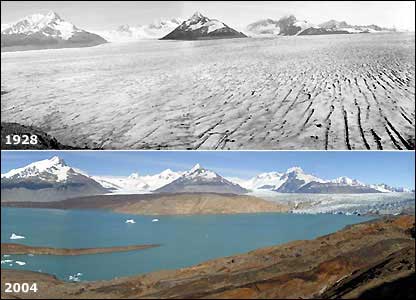Fifth Assessment Report - IPCC
Suggests that human aggravated climate disruption is widespread and persistent; and will last for centuries even if we reduced fossil fuel consumption by 80 percent.
The growing certainty of scientists around the world provides further evidence for, and mounting concern over, the capacity of human behavior to accelerate alteration of ocean chemistry, the capacity of the air to insulate temperature changes, and suggest anticipated long-term patterns.
"The Fifth Assessment Report (AR5) will provide a clear view of the current state of scientific knowledge relevant to climate change."
See– http://www.ipcc.ch/
"The atmospheric concentrations of carbon dioxide (CO2), methane, and nitrous oxide have increased to levels unprecedented in at least the last 800,000 years."
page, SPM-7.
"Continued emissions of greenhouse gases will cause further warming and changes in all components of the climate system. Limiting climate change will require substantial and sustained reductions of greenhouse gas emissions. {Chapters 6, 11, 12, 13, 14}"
page, SPM-14
Highlights | Atmosphere | Findings | Disruption | Background | Links
Highlights of AR5
"Warming of the climate system is unequivocal, and since the 1950s, many of the observed changes are unprecedented over decades to millennia. The atmosphere and ocean have warmed, the amounts of snow and ice have diminished, sea level has risen, and the concentrations of greenhouse gases have increased."
Page, SPM-4.
"Human influence on the climate system is clear. This is evident from the increasing greenhouse gas concentrations in the atmosphere, positive radiative forcing, observed warming, and understanding of the climate system." {2–14}
Page, SPM-10.
Atmosphere
"Each of the last three decades has been successively warmer at the Earth’s surface than any preceding decade since 1850 (see Figure SPM.1). In the Northern Hemisphere, 1983–2012 was likely the warmest 30-year period of the last 1400 years (medium confidence)."
Details
"Continental-scale surface temperature reconstructions show, with high confidence, multi-decadal periods during the Medieval Climate Anomaly (year 950 to 1250 ACE) that were in some regions as warm as in the late 20th century. These regional warm periods did not occur as coherently across regions as the warming in the late 20th century (high confidence)."
page, SPM-4.
Highlights | Atmosphere | Findings | Disruption | Background | Links
Findings
These are some disturbing trends:
"It is virtually certain that globally the troposphere has warmed since the mid-20th century. More complete observations allow greater confidence in estimates of tropospheric temperature changes in the extratropical Northern Hemisphere than elsewhere."
….
"Changes in many extreme weather and climate events have been observed since about 1950 (see Table SPM.1 for details). It is very likely that the number of cold days and nights has decreased and the number of warm days and nights has increased on the global scale 6. It is likely that the frequency of heat waves has increased in large parts of Europe, Asia and Australia. There are likely more land regions where the number of heavy precipitation events has increased than where it has decreased. The frequency or intensity of heavy precipitation events has likely increased in North America and Europe. In other continents, confidence in changes in heavy precipitation events is at most medium."
page, SPM-4.
"Ocean warming dominates the increase in energy stored in the climate system, accounting for more than 90% of the energy accumulated between 1971 and 2010 (high confidence). It is virtually certain that the upper ocean (0−700 m) warmed from 1971 to 2010 (see Figure SPM.3), and it likely warmed between the 1870s and 1971."
page, SPM-4.
Disrupting biological and geological chemical cycles.
• The atmospheric concentrations of the greenhouse gases carbon dioxide (CO2), methane (CH4), and nitrous oxide (N2O) have all increased since 1750 due to human activity. In 2011 the concentrations of these greenhouse gases were 391 ppm11, 1803 ppb [parts per billion], 324 ppb and exceeded the pre-industrial levels by about 40%, 150%, and 20%, respectively. {2.2, 5.2, 6.1, 6.2}
• Concentrations of CO2, CH4, and N2O now substantially exceed the highest concentrations recorded in ice cores during the past 800,000 years. The mean rates of increase in atmospheric concentrations over the past century are, with very high confidence, unprecedented in the last 22,000 years. {5.2, 6.1, 6.2}
• Annual CO2 emissions from fossil fuel combustion and cement production were 8.3 [7.6 to 9.0] GtC -gigatons of carbon 12 yr–1 averaged over 2002–2011 (high confidence) and were 9.5 [8.7 to 10.3] GtC yr–1 in 2011, 54% above the 1990 level. Annual net CO2 emissions from anthropogenic land use change were 0.9 [0.1 to 1.7] GtC yr–1 on average during 2002 to 2011 (medium confidence). {6.3}
• From 1750 to 2011, CO2 emissions from fossil fuel combustion and cement production have released 365 [335 to 395] GtC to the atmosphere, while deforestation and other land use change are estimated to have released 180 [100 to 260]
page SPM-7.
• Of these cumulative anthropogenic CO2 emissions, 240 [230 to 250] GtC have accumulated in the atmosphere, 155 [125 to 185] GtC have been taken up by the ocean and 150 [60 to 240] GtC have accumulated in natural terrestrial ecosystems (cf. cumulative residual land sink). {Figure TS.4, 3.8, 6.3}
• Ocean acidification is quantified by decreases in pH13. The pH of ocean surface water has decreased by 0.1 since the beginning of the industrial era (high confidence), corresponding to a 26% increase in hydrogen ion concentration (see Figure SPM.4). {3.8., Box 3.2}
page SPM-8.
Highlights | Atmosphere | Findings | Disruption | Background | Links
Background
Historically five reports have been made since 1992 about the evidence for atmospheric changes and oceanic conditions around the world.
"Paleoclimate reconstructions extend some records back hundreds to millions of years. Together, they provide a comprehensive view of the variability and long-term changes in the atmosphere, the ocean, the cryosphere [iced over areas], and the land surface."
pp. SPM-2 & SPM-3.
Observational and model studies of temperature change, climate feedbacks and changes in the Earth’s energy budget together provide confidence in the magnitude of global warming in response to past and future forcing. {Box 12.2, Box 13.1}
• The net feedback from the combined effect of changes in water vapour, and differences between atmospheric and surface warming is extremely likely positive and therefore amplifies changes in climate. The net radiative feedback due to all cloud types combined is likely positive. Uncertainty in the sign and magnitude of the cloud feedback is due primarily to continuing uncertainty in the impact of warming on low clouds. {7.2}
Page, SPM-11.
• Human influence has been detected in warming of the atmosphere and the ocean, in changes in the global water cycle, in reductions in snow and ice, in global mean sea level rise, and in changes in some climate extremes (Figure SPM.6 and Table SPM.1). This evidence for human influence has grown since AR4. It is extremely likely that human influence has been the dominant cause of the observed warming since the mid-20th century. {10.3–10.6, 10.9}
• It is extremely likely that more than half of the observed increase in global average surface temperature from 1951 to 2010 was caused by the anthropogenic increase in greenhouse gas concentrations and other anthropogenic forcings together. The best estimate of the human induced contribution to warming is similar to the observed warming over this period. {10.3}
Page SPM-12.
Highlights | Atmosphere | Findings | Disruption | Background | Links
http://www.climatechange2013.org/images/uploads/WGIAR5-SPM_Approved27Sep2013.pdf.
In the press from Stockholm about AR5: Working Group 1.
What should we do with what we know?
Recent Climate Change literature related to this evidence.
Periodically the Intergovernmental Panel on Climate Change, IPCC, offer's scientific reports. These began with the First Assessment Report [AR1], in 1990.
These dates are:
AR1, 1990 AR2, 1995 AR3, 2001 AR4, 2007 AR5, 2013, the most recent.
Spencer Weart | Gale Christianson | James Hansen | Contemporary | Robert Musil | David Archer | Gavin Schmidt



